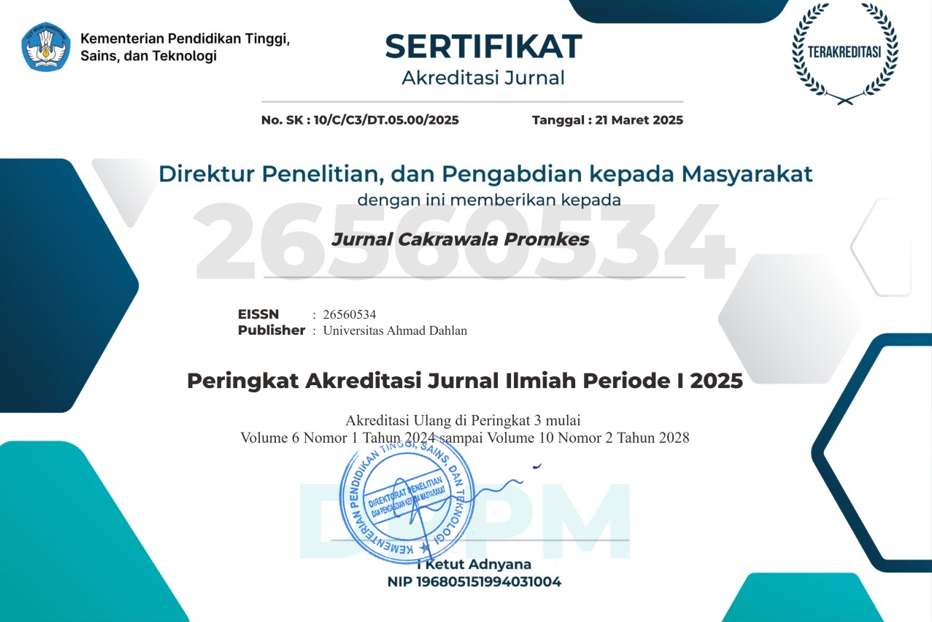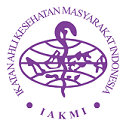Exploring teacher's role as motivators and role models in cultivating children's safe behavior: a qualitative study
DOI:
https://doi.org/10.12928/jcp.v7i1.11975Keywords:
Child Safety, Motivator, Role Model, Teacher Role'sAbstract
Children are vulnerable to injuries and accidents in school environments due to cognitive limitations. Teachers play a crucial role in shaping children's safe behavior by transferring knowledge and acting as motivators and role models. This study aims to explore how teachers influence children's safe behavior using a qualitative descriptive approach. Data was collected through observations and focus group discussions (FGDs) and analyzed using thematic analysis. Findings indicate that 67% of children's behavior at school was categorized as safe, while 33% was unsafe. Observations were conducted across the play area, learning spaces, and the street in front of the school. Teachers have actively encouraged safe behavior by providing support and motivation. However, some students continue engaging in unsafe practices despite these efforts. Teachers also attempt to model safe behavior, such as walking calmly in hallways and sitting properly in classrooms. However, FGD findings revealed that half of the teachers did not fully practice safe behavior, notably by failing to wear helmets when riding motorcycles to school. In conclusion, teachers at SD Negeri Krajan have effectively acted as motivators, encouraging students to adopt safe behavior. However, their role as role models remains inconsistent, highlighting the need for greater self-adherence to safety practices. Strengthening teachers' commitment to modeling safe behavior could enhance the effectiveness of safety education in schools.
References
Mulyani N. Emotional and Social Development an Early Childhood. INSANIA. 2013;18:423–38. https://doi.org/10.24090/insania.v18i3.1470
Khaulani F, S N, Irdamurni I. Phase and Stages Of Development For Primary Students. J Ilm Pendidik Dasar. 2020;7:51. https://doi.org/10.30659/pendas.7.1.51-59
Vinje MP. Children as pedestrians: Abilities and limitations†. Accid Anal Prev. 1981;13:225–40. https://doi.org/10.1016/0001-4575(81)90006-3
Yusvita F. School Safety Education for Students of SDN 11 Pagi Duri Kepa, West Jakarta. J Abdimas. 2016;3:45–50. https://doi.org/10.47007/abd.v3i1.1660
Tri W. Early Childhood Self-Safety Education (Case Study at Gaharu Plus Playgroup, Kutai Kartanegara). J Ilm Visi PGTK PAUD dan Dikmas. 2018;13:113–23. https://doi.org/10.21009/JIV.1302.5
Mahboob A, Richmond SA, Harkins JP, Macpherson AK. Childhood unintentional injury: The impact of family income, education level, occupation status, and other measures of socioeconomic status. A systematic review. Paediatr Child Heal. 2021;26:E39–45. https://doi.org/10.1093/pch/pxz145
GoodStats. Traffic Accident Rate Continues to Rise, Student Age Dominates. 2023;
Siregar Z, Dewi I. Analysis of Cross Sumatra Road Sections in Tebing Tinggi City and Kisaran as Traffic Accident Prone Points. J MESIL (Mesin Elektro Sipil). 2020;1:63–73. https://doi.org/10.53695/jm.v1i2.88
Mubalus SFE. Analysis of the Traffic Accident Factors in Sorong District and How To Manage Them. Soscied. 2023;6:182–97. https://doi.org/10.32531/jsoscied.v6i1.624
Muryatma NM. Relationships Between Safety Riding Factors with Safety Riding Behaviour. J PROMKES. 2018;5:155. https://doi.org/10.20473/jpk.V5.I2.2017.155-166
Suryati S, Tamam AM, Supraha W. Behavioral education for elementary school children. Acad Educ J. 2024;15:642–7. https://doi.org/10.47200/aoej.v15i1.2273
Zagoto H, Harefa D. Analysis Of The Teacher’s Role in the Learning Process. J Pendidik Pancasila dan Kewarganegaraan. 2023;85–98.
Azizah W. The Role of Teachers in Shaping Student Behavior at SMA Muhammadiyah Kupang. PENSOS J Penelit dan Pengabdi Pendidik Sosiol. 2023;1:55–61. https://doi.org/10.59098/pensos.v1i2.1298
Arifin H. Capita Selekta Education (Islamic and General). Ed. 2, Cet. Jakarta: Bumi Aksara; 1995.
Hanaris F. The Role of Teachers in Increasing Student Learning Motivation: Effective Strategies and Approaches. J Kaji Pendidik dan Psikol. 2023;1:1–11. https://doi.org/10.61397/jkpp.v1i1.9
Manizar E. The teacher’s role as a motivator in learning. J Pendidik Agama Islam. 2015;Vol. 1:171. https://jurnal.radenfatah.ac.id/index.php/Tadrib/article/view/1047
Afifah Khoirun Nisa. The Role of Teachers in Character Education of Students in SDIT Ulul Albab 01 Purworejo. J Hanata Widya. 2019;8:13–22.
Arsini Y, Yoana L, Prastami Y. The Role of the Teacher as a Model in Shaping Students’ Character. J Res Educ Stud. 2023;3:27–35. https://doi.org/10.56832/mudabbir.v3i2.368
Sumargi AM, Kurniawan Y, Sasongko JW, Simanjuntak E. What Elementary School Children Know about Self-Safety: A Preliminary Study on Understanding Self-Safety. Insan. 2005;7 No. 3:226–49.
Anggito A dan JS. Qualitative Research Methodology. Sukabumi, Jawa Barat: Jejak Publisher; 2018.
Heriyanto H. Thematic Analysis as a Method of Analyzing Data for Qualitative Research. Anuva. 2018;2:317. https://doi.org/10.14710/anuva.2.3.317-324
Imron Fauzi. Ethics of the Teaching Profession. 2018.
Hafiz M, Muhammad D, Habibullah S, Farid Aulia M, Lesmana DG. Capita Selekta Education: The Important Role of Teachers as Student Motivators. J Edukasi Nonform. 2023;4:465–71.
Sudrajat R. The Importance of Listening Skills to Create Engaging Learning. Semin Nas Ke-Indonesiaan VIII. 2023;8:2613–30.
Febianti YN. Increasing Learning Motivation With Positive Rewards and Punishment. J Edunomic. 2018;6:93–102. https://doi.org/10.33603/ejpe.v6i2.1445
Umar FPY dan AF. Application Analysis of Occupational Safety based on the ABC Behavior Model (Antecedent, Behavior, Consequence) for Workers at PT Adhi Persada Beton West Factory Purwakarta. J Persada Hus Indo 2019;6:11–24. https://doi.org/10.56014/jphi.v6i23.274
Dwiyanti AI dan E. Analysis of Worker Safe Behaviour Usi ng the ABC (Antecedent Behavior Consequence) Behaviour Model. Indones J Occup Saf Heal. 2020;9:3. https://doi.org/10.20473/ijosh.v9i3.2020.309-317
Julaikah. The Role of Consequences (C) in the Use of Personal Protective Equipment on Workers UPT Balai Yasa Yogyakarta. Med Respati. 2018;11–7. https://doi.org/10.35842/mr.v13i0.136
Amiruddin A, Sarah DM, Vika AIV, Hasibuan N, Sipahutar MS, Simamora FEM. The Effect of Reward and Punishment on Student Motivation. Edu Cendikia J Ilm Kependidikan. 2022;2:210–9. https://doi.org/10.47709/educendikia.v2i01.1596
Skinner B. Beyond Freedom and Dignity. Amerika: Hachkett Publishing Company, incorporatet; 2002.
Cahyati S. Teachers of Character for Character Education in Schools. Acad Educ J. 2020;11:63–74. https://doi.org/10.47200/aoej.v11i01.319
Hawa S. Role of the Teacher as a Role Model According to the Concept of Albert Bandura in Implementing. 2022;19:135–51. https://doi.org/10.58645/jurnalazkia.v15i1.203
Bandura A. Social Learning Theory. Michigan: Amerika Serikat: Prentice Hall; 1977.
Downloads
Published
Issue
Section
License
Copyright (c) 2025 Hani Auliya Rahmah, Mahfuzah Mahfuzah, Julaikah Julaikah, Rofiatun Rofiatun, Sri Yuni Tursilowati

This work is licensed under a Creative Commons Attribution-ShareAlike 4.0 International License.
Authors who publish with JCP: Jurnal Cakrawala Promkes agree to the following terms:
- Authors retain copyright and grant the journal the right of first publication with the work simultaneously licensed under a Creative Commons Attribution License (CC BY-SA 4.0) that allows others to share the work with an acknowledgement of the work's authorship and initial publication in this journal.
- Authors are able to enter into separate, additional contractual arrangements for the non-exclusive distribution of the journal's published version of the work (e.g., post it to an institutional repository or publish it in a book), with an acknowledgement of its initial publication in this journal.
- Authors are permitted and encouraged to post their work online (e.g., in institutional repositories or on their website) prior to and during the submission process, as it can lead to productive exchanges, as well as earlier and greater citation of published work.

This work is licensed under a Creative Commons Attribution-ShareAlike 4.0 International License












